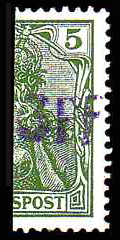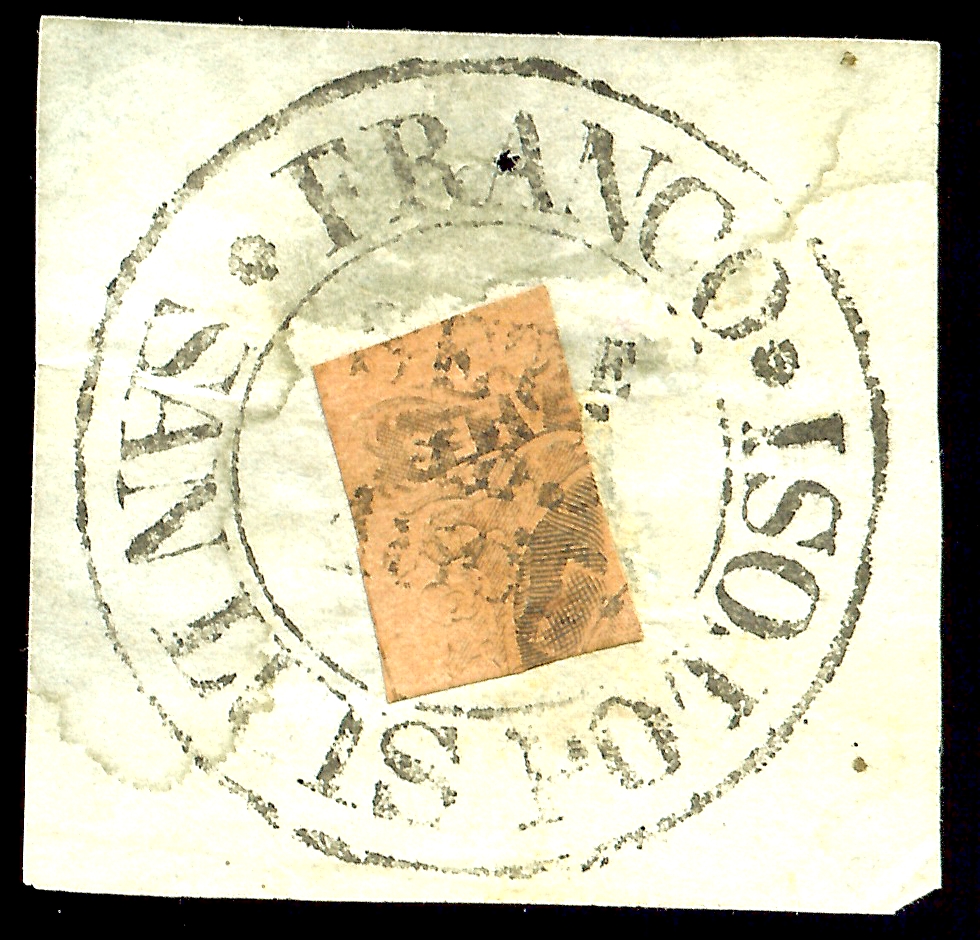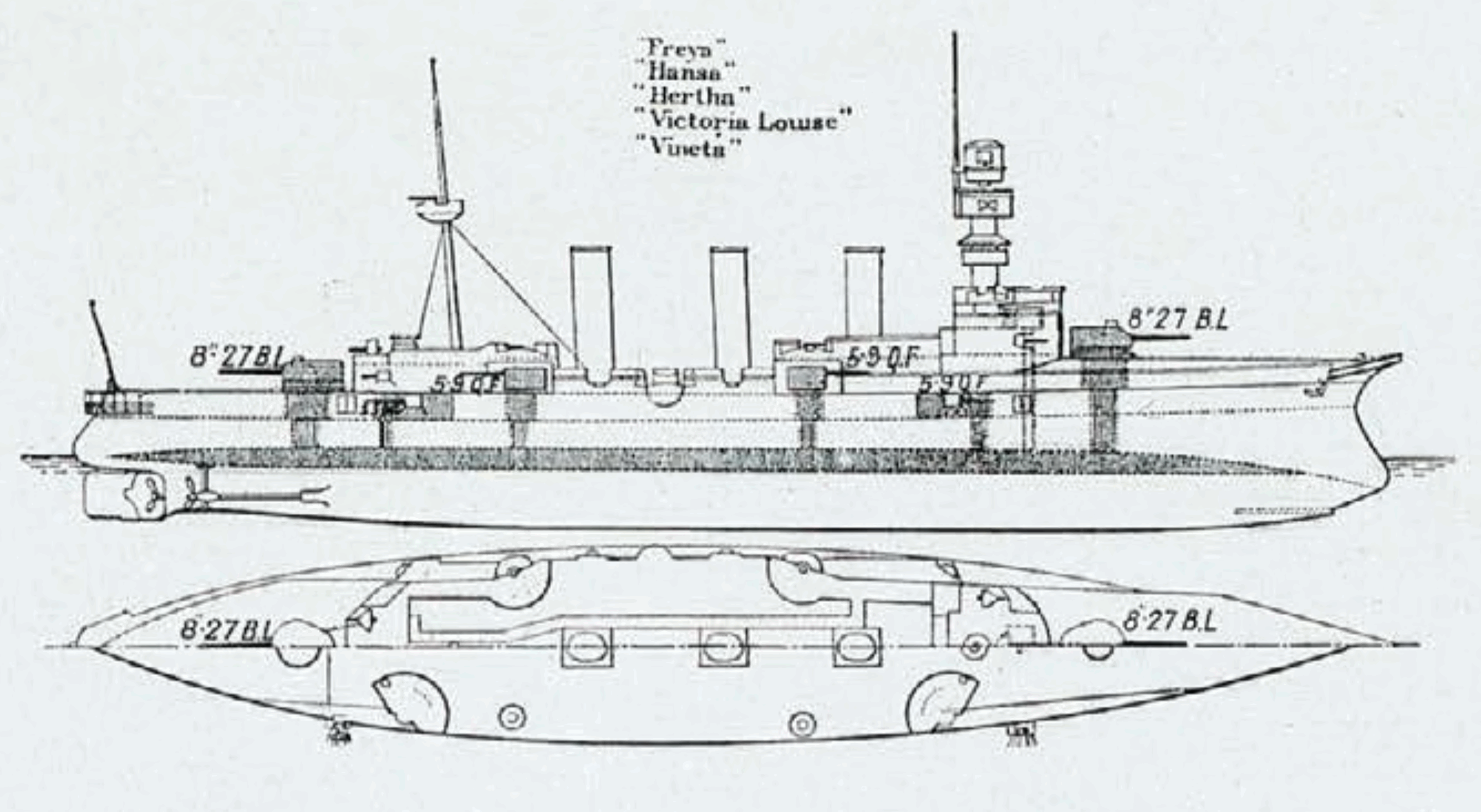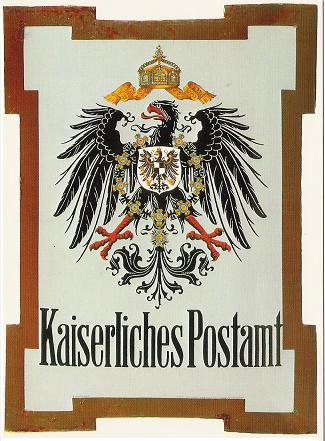|
Vineta Provisional
The Vineta Provisional (german: Vineta-Provisorium) is a German postage stamp made on 13 April 1901 on board the cruiser SMS ''Vineta''. The postal officer had not been supplied with 3 Pfennig Germania stamps, so he bisected his 5 Pfennig stamps (Michel Nummer 55) and stamped them by hand with a "3 PF" mark. Mail with the Vineta provisional stamp was sent from Pernambuco to Germany on 17 April 1901. Only 600 stamps were issued, making this provisional stamp one of the rarer stamps in German philately. Catalogue status The stamp gained notoriety after it was included in the Michel catalogue as a regular stamp and given the number 67. Collectors who aspired to put together a complete collection of issues of the Reichspost had an interest in acquiring this stamp. However, because philatelists generally considered the stamp a self-made variety, not an official issue by the Reichspost, the #67 assignment was heavily criticised and eventually withdrawn. As a result, prices for the ... [...More Info...] [...Related Items...] OR: [Wikipedia] [Google] [Baidu] |
German Empire
The German Empire (),Herbert Tuttle wrote in September 1881 that the term "Reich" does not literally connote an empire as has been commonly assumed by English-speaking people. The term literally denotes an empire – particularly a hereditary empire led by an emperor, although has been used in German to denote the Roman Empire because it had a weak hereditary tradition. In the case of the German Empire, the official name was , which is properly translated as "German Empire" because the official position of head of state in the constitution of the German Empire was officially a "presidency" of a confederation of German states led by the King of Prussia who would assume "the title of German Emperor" as referring to the German people, but was not emperor of Germany as in an emperor of a state. –The German Empire" ''Harper's New Monthly Magazine''. vol. 63, issue 376, pp. 591–603; here p. 593. also referred to as Imperial Germany, the Second Reich, as well as simply Germany, ... [...More Info...] [...Related Items...] OR: [Wikipedia] [Google] [Baidu] |
Bisect (philately)
Bisects and splits refer to postage stamps that have been cut in part, most commonly in half, but also other fractions, and postally used for the proportionate value of the entire stamp, such as a two cent stamp cut in half and used as a one cent stamp. When stocks of a certain stamp ran out, postmasters sometimes resorted to cutting higher denominated stamps in half, vertically or diagonally, thus obtaining two "stamps" each representing half of the original monetary value, or "face" value, of the uncut stamp. The general public also resorted to this practice, sometimes pursuant to official or tacit permission and sometimes without any express authorization. Many of these instances have been well documented in postal history. One example is the bisects of the Island of Guernsey during the German military occupation of the Channel Islands during World War II. Early Mexican stamps are known to have been used cut in half, three-quarters, quarters and even eighths. Many bisects and ... [...More Info...] [...Related Items...] OR: [Wikipedia] [Google] [Baidu] |
Overprint
An overprint is an additional layer of text or graphics added to the face of a postage or revenue stamp, postal stationery, banknote or ticket after it has been printed. Post offices most often use overprints for internal administrative purposes such as accounting but they are also employed in public mail. Well-recognized varieties include commemorative overprints which are produced for their public appeal and command significant interest in the field of philately. Surcharges The term "surcharge" in philately describes any type of overprint that alters the price of a stamp.Williams & Williams, p. 258. Surcharges raise or lower the face value of existing stamps when prices have changed too quickly to produce an appropriate new issue, or simply to use up surplus stocks. Any overprint which restates a stamp's face value in a new currency is also described as a surcharge. Some postal systems have resorted to surcharge overprints when converting to a new national monetary syst ... [...More Info...] [...Related Items...] OR: [Wikipedia] [Google] [Baidu] |
Postage Stamp
A postage stamp is a small piece of paper issued by a post office, postal administration, or other authorized vendors to customers who pay postage (the cost involved in moving, insuring, or registering mail), who then affix the stamp to the face or address-side of any item of mail—an envelope or other postal cover (e.g., packet, box, mailing cylinder)—that they wish to send. The item is then processed by the postal system, where a postmark or cancellation mark—in modern usage indicating date and point of origin of mailing—is applied to the stamp and its left and right sides to prevent its reuse. The item is then delivered to its addressee. Always featuring the name of the issuing nation (with the exception of the United Kingdom), a denomination of its value, and often an illustration of persons, events, institutions, or natural realities that symbolize the nation's traditions and values, every stamp is printed on a piece of usually rectangular, but sometimes triangular ... [...More Info...] [...Related Items...] OR: [Wikipedia] [Google] [Baidu] |
SMS Vineta (1897)
SMS was a protected cruiser of the , built for the German Imperial Navy () in the 1890s. was laid down at the AG Vulcan shipyard in 1895, launched in April 1897, and commissioned into the Navy in July 1898. The ship, named for the semi-legendary medieval town of Vineta, was armed with a battery of two 21 cm guns and eight 15 cm guns and had a top speed of . served abroad in the American Station for the first several years of her career. While on station in the Americas, she participated in the Venezuela Crisis of 1902–1903 and bombarded several Venezuelan fortresses. She returned to Germany in 1905 and was used as a torpedo training ship in 1908. She was modernized in 1909–1911, after which she was used as a school ship for naval cadets. In November 1912, she participated in an international naval protest of the First Balkan War. At the outbreak of World War I, was mobilized into V Scouting Group, but served in front-line duty only briefly. She was u ... [...More Info...] [...Related Items...] OR: [Wikipedia] [Google] [Baidu] |
Germania Stamp
Germania stamps are definitive stamps that were issued by the German Empire and the Weimar Republic between 1900 and 1922, depicting Germania. They represent the longest running series in German philately and are in their many variations and derivations an essential part of German philatelic collections. Design The initial issue from January 1, 1900, replaced the standard issue depicting numbers and eagles. The image of Germania, rather than that of the ruling monarch as was customary in many other European monarchies, made it a unifying feature and did not complicate the relationship with other German royalty and the coexisting German postal authorities of Bavaria and Württemberg. The engraving was performed by Paul Eduard Waldraff (1870–1917) who used the actress Anna Führing as model. Wearing an octagonal imperial crown she is holding a sword and an olive branch. The Jugendstil design depicting Führing was personally chosen by the emperor Wilhelm II. Issues inside ... [...More Info...] [...Related Items...] OR: [Wikipedia] [Google] [Baidu] |
Pernambuco
Pernambuco () is a state of Brazil, located in the Northeast region of the country. With an estimated population of 9.6 million people as of 2020, making it seventh-most populous state of Brazil and with around 98,148 km², being the 19th-largest in area among federative units of the country, it is the sixth-most densely populated with around 89 people per km². Its capital and largest city, Recife, is one of the most important economic and urban hubs in the country. Based on 2019 estimates, the Recife Metropolitan Region is seventh-most populous in the country, and the second-largest in northeastern Brazil. In 2015, the state had 4.6% of the national population and produced 2.8% of the national gross domestic product (GDP). The contemporary state inherits its name from the Captaincy of Pernambuco, established in 1534. The region was originally inhabited by Tupi-Guarani-speaking peoples. European colonization began in the 16th century, under mostly Portuguese rule in ... [...More Info...] [...Related Items...] OR: [Wikipedia] [Google] [Baidu] |
Philately
Philately (; ) is the study of postage stamps and postal history. It also refers to the collection and appreciation of stamps and other philatelic products. Philately involves more than just stamp collecting or the study of postage; it is possible to be a philatelist without owning any stamps. For instance, the stamps being studied may be very rare or reside only in museums. Etymology The word "philately" is the English transliteration of the French "", coined by Georges Herpin in 1864. Herpin stated that stamps had been collected and studied for the previous six or seven years and a better name was required for the new hobby than ''timbromanie'' (roughly "stamp quest"), which was disliked.Williams, L.N. & M. ''Fundamentals of Philately''. State College: The American Philatelic Society, 1971, p.20. The alternative terms "timbromania", "timbrophily", and "timbrology" gradually fell out of use as ''philately'' gained acceptance during the 1860s. Herpin took the Greek root word ... [...More Info...] [...Related Items...] OR: [Wikipedia] [Google] [Baidu] |
Michel Catalogue
The Michel catalog (''MICHEL-Briefmarken-Katalog'') is the largest and best-known stamp catalog in the German-speaking world. First published in 1910, it has become an important reference work for philately, with information not available in the English-language Scott catalog. Origins The catalog started out as a price list for the dealer Hugo Michel of Apolda. By 1920 it was split into two volumes, for "Europe" and "overseas", and eventually grew to a present-day size of about a dozen volumes covering the entire world, with additional specialized volumes bringing the total to some forty catalogs. Scope It extensively covers specialized Germany collecting including the complex World War II era stamps of Germany, occupied territories, and provisional stamps. Unlike Scott, Michel does not issue a complete set of catalogs every year, instead updating only several of the volumes. Michel is also more detailed, with quantities issued, sheet formats, and so forth. Also of signifi ... [...More Info...] [...Related Items...] OR: [Wikipedia] [Google] [Baidu] |
Reichspost
''Reichspost'' (; "Imperial Mail") was the name of the postal service of Germany from 1866 to 1945. ''Deutsche Reichspost'' Upon the out break of the Austro-Prussian War of 1866 and the break-up of the German Confederation in the Peace of Prague, the North German Confederation was established, instigated by the Prussian minister-president Otto von Bismarck. Originally a military alliance, it evolved to a federation with the issuing of a constitution with effect from 1 July 1867. In the course of the war, Prussian troops had occupied the Free City of Frankfurt and the King of Prussia (later to become German Emperor) had purchased the remnants of the Thurn-und-Taxis Post organisation. According to article 48, the federal area of the Northern German states, ''de facto'' an enlarged Prussia, came under the united postal authority, led by director Heinrich von Stephan. With the German unification upon the Franco-Prussian War of 1870–1871, the ''Deutsche Reichspost'' was esta ... [...More Info...] [...Related Items...] OR: [Wikipedia] [Google] [Baidu] |
Philatelic Fakes And Forgeries
In general, philatelic fakes and forgeries are labels that look like postage stamps but have been produced to deceive or defraud. Learning to identify these can be a challenging branch of philately. To a large extent the definitions below are consistent with those given in the introduction to various recent editions of the ''Scott Standard Postage Stamp Catalogue''. "We use the term ''"forgery"'' to indicate stamps produced to defraud collectors (properly known as forgeries) and to defraud stamp-issuing governments (properly known as counterfeits). ''"Fake"'' is used to indicate the alteration of a genuine stamp to make it appear as something else. Fakes might refer to cancellations, overprints, added or clipped perforations, stamp design alterations, etc." While difficult to do today, one famous case is the Stock Exchange forgery of the late 19th century. Questions are often raised about when a stamp is legitimately produced for postage. Matthew Karanian has proposed the f ... [...More Info...] [...Related Items...] OR: [Wikipedia] [Google] [Baidu] |









